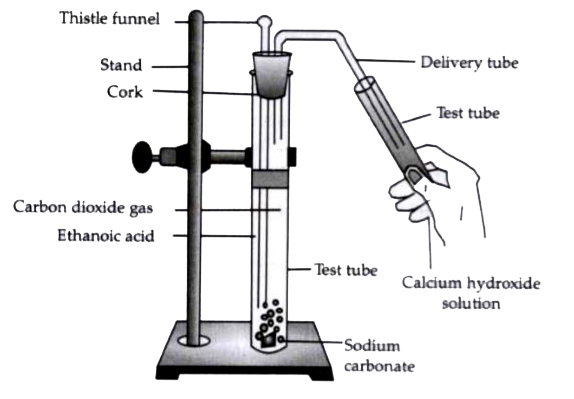What do you observe when dil. HCl is added on Zn pieces taken in a test tube? How would you identify the gas evolved? Write on use of this gas.
Observation. A colourless gas is evolved with brisk bubbles from the test tube.
When a burning match stick is brought near the gas, then the gas burns with a pop sound.
The gas evolved is H2 gas.
H2 gas is used as fuel in the space crafts.
Topper's Solved these Questions
- BOOK - X BOARDSCHAPTER - X BOARDSEXERCISE - SET-I SECTION-B2videos
X BOARDS
- BOOK - X BOARDSCHAPTER - X BOARDSEXERCISE - SET-I SECTION-C4videos
X BOARDS
- BOOK - X BOARDSCHAPTER - X BOARDSEXERCISE - SET III (SECTION -C)1videos
X BOARDS
- BOOK - X BOARDSCHAPTER - QUESTION PAPER 2023EXERCISE - Question24videos
QUESTION PAPER 2023
Similar Questions
Knowledge Check
- Question 1 - Select One
When dilute hydrochloric acid is added to zinc pieces taken in a test tube
Ano change takes placeBthe colour of the solution becomes yellowCa pungent smelling gas gets liberatedDsmall bubbles of hydrogen gas appear on the surface of zinc pieces. - Question 2 - Select One

What is the test to identify that the evolved gas is carbon dioxide.AIt gives pop up sound.BIt turns lime water milky.CIt has smell of rotten eggs.DIt helps burning
Name two metals which react vilently with cold water. Write any three observations you would make when such a metal is dropped into water. How would you identify the gas evolved, if any during the reaction?
View SolutionHow would you test that a given gas is carbon dioxide ?
View SolutionName two metals which react violently with cold water. Write any three observations which you would make when such a metal is dropped into water. How would you identify the gas evolved, if any, during the reaction ?
View SolutionName the gas evolved when ethanoic acid reacts with sodium carbonate. How would you identify this gas?
View SolutionA gas is produced when conc. H2SO4 is added to solid sodium chloride taken in a test tube. The gas coming out of the delivery tube is passed over a dry blue litmus paper and then over a moist blue litmus paper. What would you observe ? Explain reason with the help of a chemical equation.
View SolutionDiagram below depicts an experiment to find the effect of temperature on the rate of photosynthesis. The average number of bubbles per minute at each temperature is given in the table.

(i) Name the gas collected.
(ii) What test would you do to identify the gas?
(iii) What is the importance of this gas to other organisms in the ecosystem?View Solution

